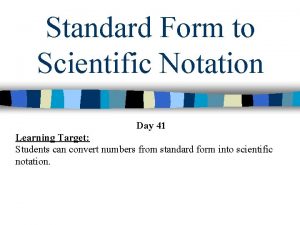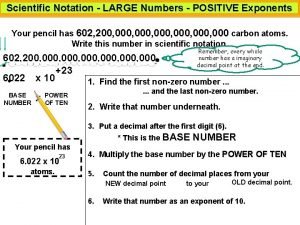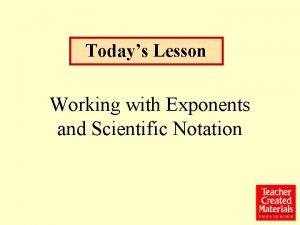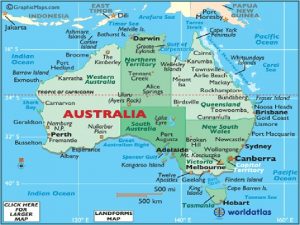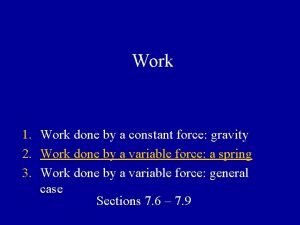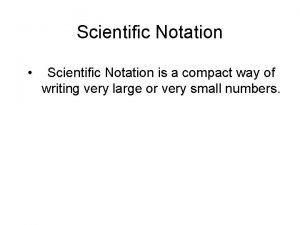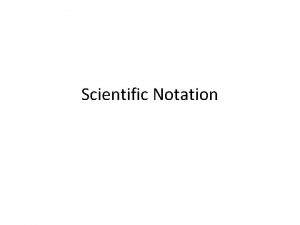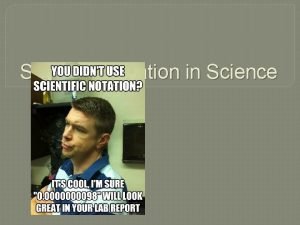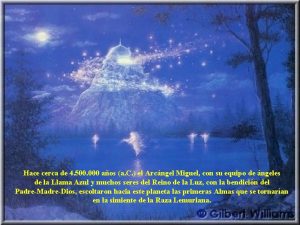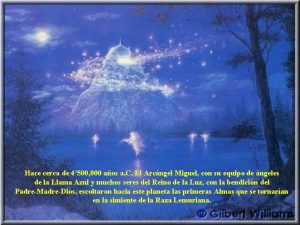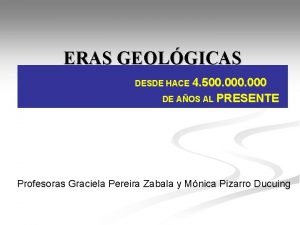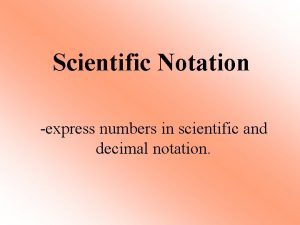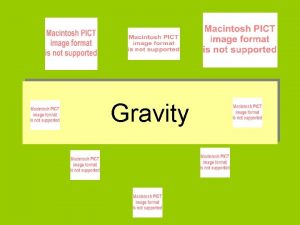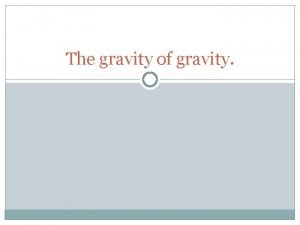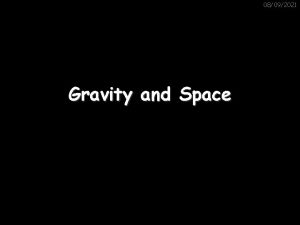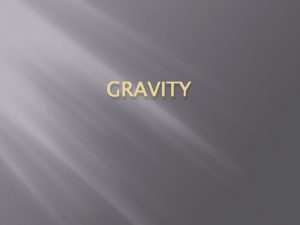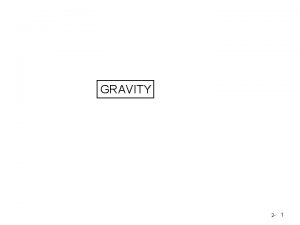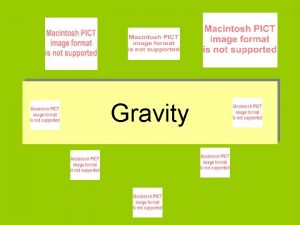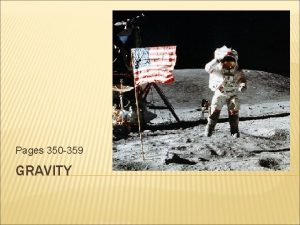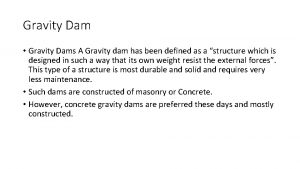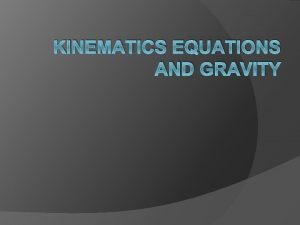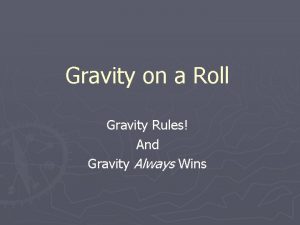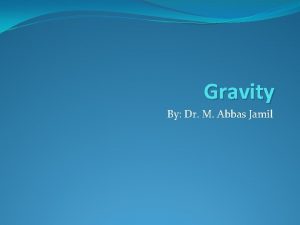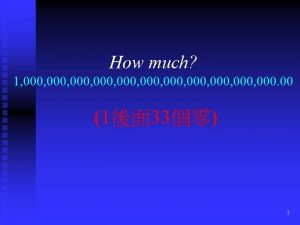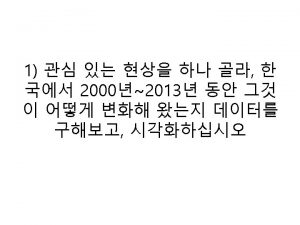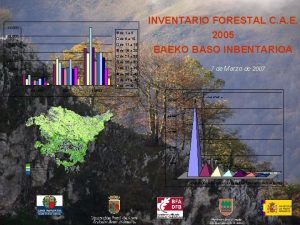9 000 000 Years of Gravity at Work





































- Slides: 37

9, 000, 000 Years of Gravity at Work in the Cosmic Factory Christian Marinoni Centre de Physique Théorique Université de Provence Nice 25 -27 Jan 2005

Outline • Galaxy bias - Biasing from a theoretical & observational perspective • The survey of the LSS at high z - Results : biasing properties up to z=1. 5 • Cosmological implication of our results - Test of the Gravitational Instability Paradigm (GIP) Marinoni et al. 2005 A&A in press (astro-ph/0506561)

Theoretical Background: Dynamics of matter fluctuations t

So what’s the problem? Formation and evolution of luminous matter Dynamics of galaxy fluctuations • Where and when did galaxies form? • How do they evolve? • Formal problem: Biasing scheme

From an observational point of view. . • Biasing must exist on both small and large cosmological scales! - Halo and galaxy profiles - Galaxies of different types cluster differently - Void phenomenon

From an observational point of view. . • Biasing must exist on both small and large cosmological scales! - Halo and galaxy profiles - Galaxies of different types cluster differently - Void phenomenon • Biasing relation depends in principle on some “hidden” variable. . . g= g( , A 1, A 2, A 3. . . t) Stochasticity in the plane g

From an observational point of view. . • Biasing must exist on both small and large cosmological scales! - Halo and galaxy profiles - Galaxies of different types cluster differently - Void phenomenon • Biasing relation depends in principle on some “hidden” variable. . . g= g( , A 1, A 2, A 3. . . t) Stochasticity in the plane g • Up to now most measurement methods constrain i. e. measure only linear bias (scalar parameter)

Where do we stand with observations No bias locally. At present time ligh follows matter

Where do we stand with observations At high z , blue galaxies more correlated than matter

Where do we stand with observations Extremely red objects at z~1 more clustered w/r to blue

Where do we stand with observations

Where do we stand with observations Conflicting evidences about biasing evolution!

Outline • Galaxy bias - Biasing from a theoretical & observational perspective • The survey of the LSS at high z - Results : biasing properties up to z=1. 5 • Cosmological implication of our results - Test of the Gravitational Instability Paradigm (GIP)

The : Vimos-VLT Redshift Survey French-Italian team : P. I. Olivier Le. Fèvre – Laboratoire d ’Astrophysique (Marseille): Adami, Arnouts, Foucaud, Ilbert, Le Brun, Mazure, Meneux, Paltani, Tresse – OABo, IRA-CNR (Bologna): Bardelli, Bondi, Bongiorno, Cappi, Ciliegi, Marano, Pozzetti, Scaramella (Rome), Vettolani, Zamorani, Zanichelli, Zucca – IASF, OABr (Milan): Bottini, Cucciati, Franzetti, Garilli, Guzzo, Iovino, Maccagni, Marinoni, Pollo, Scodeggio – IAP (Paris): Charlot (MPA), Colombi, Mc. Cracken, Mellier – OAC (Naples): Arnaboldi, Busarello, Radovich – OMP (Toulouse): Contini, Mathez, Pello, Picat, Lamareille

The in a nutshell Imaging Survey (CFHT, ESO-MPI 2. 2, ESO-NTT) Mc. Cracken et al 2004, Radovich et al. 2004, Iovino 2005 § § § 16 sq. deg in 4 fields 2 2 deg 2 L~100 h-1 Mpc at z~1 6 (U)BVRI(K) filters, ~3 x 10 objects Spectroscopic Survey (Vimos at VLT): Le. Fèvre et al 2004 AA in press (astroph/0409133) § § § Purely flux -limited survey, No preselections 16 deg down to I=22. 5, z<1. 3, 36000 observed 1 deg down to I=24, z<2, 13000 observed Public data release on http: //cencosw. oamp. fr

Sample: Deep “cone” (2 h Field: first-epoch data) z=1. 5 • ~7000 galaxies with secure redshifts, IAB 24 • Coverage: 0. 7 x 0. 7 sq. deg (40 x 40 Mpc at z=1. 5) • Volume sampled: 2 x 106 Mpc 3 (~Cf. A 2) (1/16 th of final goal) pc 43 M 0 0 • Mean inter-galaxy separation at z=0. 8 <l>~4. 3 Mpc (~2 d. F at z=0. 1) • Sampling rate: 1 over 3 galaxies down to I=24 z=0

The Density Field (smoothing R=2 Mpc) 2 DFGRS/SDSS stop here The Probability Distribution Function (PDF) of galaxy overdensities Probability of having a density fluctuation in the range ( , +d ) within a sphere of radius R randomly located in the survey volume f. R( ) High density Low density

Time Evolution of the galaxy PDF The 1 P-PDF of galaxy overdensities g ( ) R Z=1. 1 -1. 5 • The PDF is different at different cosmic epochs Z=0. 7 -1. 1 • Systematic shift of the peak towards low density regions as a function of cosmic time • Cosmic space becomes dominated by low density regions at recent epochs Volume limited sample M<-20+5 log h

A possible Interpretation Gravitational instability in an expanding universe ? ? ?

The PDF of mass overdensities f( ): Shape Z=0. 7 -1. 1 Z=1. 1 -1. 5 Lognormal! (Coles & Jones 1991) Conclusion: Galaxies are Spatially distributed in a different way (biased) with respect to dark matter at high z

Measuring the galaxy bias up to z=1. 5 with the VVDS Bias: difference in distribution of DM and galaxy fluctuations Linear Bias Scheme: (Kaiser 1984) • Redshift evolution Our goal: • Non linearity • Scale dependence Strategy § Derive the biasing function Sigad et al 2000 Marinoni & Hudson 2002 Ostriker et al. 2003

The PDF of galaxy overdensities g ( ): Shape Z=0. 7 -1. 1 Z=1. 1 -1. 5

The biasing function: Time evolution • Scale independent on 5 < R(Mpc) < 10 2 d. F (Norberg et al. 04) • Galaxies were progressively more biased mass tracers in the past • Evolution: weak for z < 0. 8 stronger for z > 0. 8

The biasing function: 2) Shape b( ) L 15 Mpc Smoothing • Non linearity at a level <10% on scales 5<R<10 Mpc (Local slope is steeper (bias stronger) in underdense regions) • Also at high z, galaxy bias depends on luminosity: More luminous galaxies are more spatially segregated with respect to DM • Luminous galaxies do not form in underdense regions

The biasing function: 2) Shape b( ) z • At present epochs galaxies form also in low density regions, while at high z the formation process is inhibited in underdensities

The Problem: Formation and Evolution of luminous matter Dynamics of galaxy fluctuations • Where do galaxies form? In the high density peaks of the dark matter distribution • How do they evolve: As time goes by they start forming also in low density regions

Theoretical Interpretation: Which is the physical mechanism governing biasing evolution? Merging (Mo & White `96 Matarrese et al `97) Istantaneous Star Formation (Blanton et al `02) Gravity (Dekel and Rees `88 Tegmark & Peebles `98)

Outline • Cosmological bias (definition) - Biasing from a theoretical perspective - Biasing from an observational point of view • The VVDS survey of the LSS at high z - A new method to measure biasing - Results : biasing properties up to z=1. 5 • Cosmological implication of our results - Test of the Gravitational Instability Paradigm

Test of the Gravitational Instability Paradigm ~ costant with z decrease with z Volume limited sample M<-20+5 log h

Test of the Gravitational Instability Paradigm Peebles 1980 Juskiewicz et al. 1993

Conclusions • Determination of the PDF of galaxy fluctuations from a complete Volume-limited redshift survey covering the range 0. 5< z <1. 5 (large connected sky regions, all the galactic populations). • The bias function is complex! First time detection of non linearity on large scales (10% effect). • Significant evolution of the `linearized’ bias 0. 7<z<1. 5. • No single simple physical model is able to describe the observed evolution. • Low order moments of the galaxy PDF evolve as predicted by the linear and second order perturbation theory. GIP predictions consistent over 9, 000, 000 years

Reconstruction Completeness

Is the lognormal PDF of mass a good approximation of reality? CDM Hubble Volume simulation (Virgo cons. )

Test of the Gravitational Instability Paradigm : Motivation The Origin of the Large Scale Structure is one of the key issue in Cosmology. A plausible assumption is that structures grow via gravitational collapse of density fluctuations that are small at early times, but is vital to test this hypothesis. J. A. Peacock, Nature 2002 Is gravity the engine of the cosmic factory?

Growth of Cosmic Structures Fundamental variable for LSS studies: The Matter Fluctuation Field -1 r The Evolution of the LSS in linear approximation. . . Continuity eq. + Poisson eq. Initial Condition: Primordial Power Spectrum Assume knowledge of cosmological background SNIa+Wmap measurements Friedmann eq. Harrison Zel’dovich.

Reconstruction of the Galaxy Density Field • Top-Hat smoothing on various scales R (5 -15 Mpc) • Correction for radial selection function of the sample • Correction for the VVDS sampling rate • Shot noise minimization (Wiener-filter in Fourier space)

The PDF of mass: ( ) Real Space Model Cole 1992 Problem: we measure galaxies in redshift space! Kaiser 87
 97 000 000 in scientific notation
97 000 000 in scientific notation Express 602200 in scientific notation.
Express 602200 in scientific notation. 71 000 in scientific notation
71 000 in scientific notation Gravity for dummies and dummies for gravity equations
Gravity for dummies and dummies for gravity equations 090-0000-0000
090-0000-0000 Goat years to human years
Goat years to human years 300 solar years to lunar years
300 solar years to lunar years Where is this image
Where is this image Australia 50 000 years ago
Australia 50 000 years ago 4 000 years ago
4 000 years ago The work done by gravity during the descent of a projectile
The work done by gravity during the descent of a projectile Revive thy work in the midst of the year
Revive thy work in the midst of the year How did rudolph virchow summarize his years of work
How did rudolph virchow summarize his years of work Express 4,980,000, 000 in scientific notation
Express 4,980,000, 000 in scientific notation 140 000 000 in scientific notation
140 000 000 in scientific notation 2,340,000,000
2,340,000,000 2340000000
2340000000 011 101 110
011 101 110 1, 10, 100, 1000
1, 10, 100, 1000 What are some of the advantages of scientific notation?
What are some of the advantages of scientific notation? 4 500 000
4 500 000 1-000-000-0000
1-000-000-0000 Micro nano pico
Micro nano pico 450 000 in scientific notation
450 000 in scientific notation 123 000 000 in scientific notation
123 000 000 in scientific notation 1 600 000
1 600 000 1,000 x 3,000
1,000 x 3,000 4 500 000 000
4 500 000 000 4 500 000
4 500 000 4 500 000
4 500 000 240 000
240 000 27x10^3 in scientific notation
27x10^3 in scientific notation Pedipalpos quelados
Pedipalpos quelados 60 000 000
60 000 000 4 000 000
4 000 000 Resume format sample for work immersion
Resume format sample for work immersion Wrap up work immersion
Wrap up work immersion Working smart vs working hard
Working smart vs working hard
